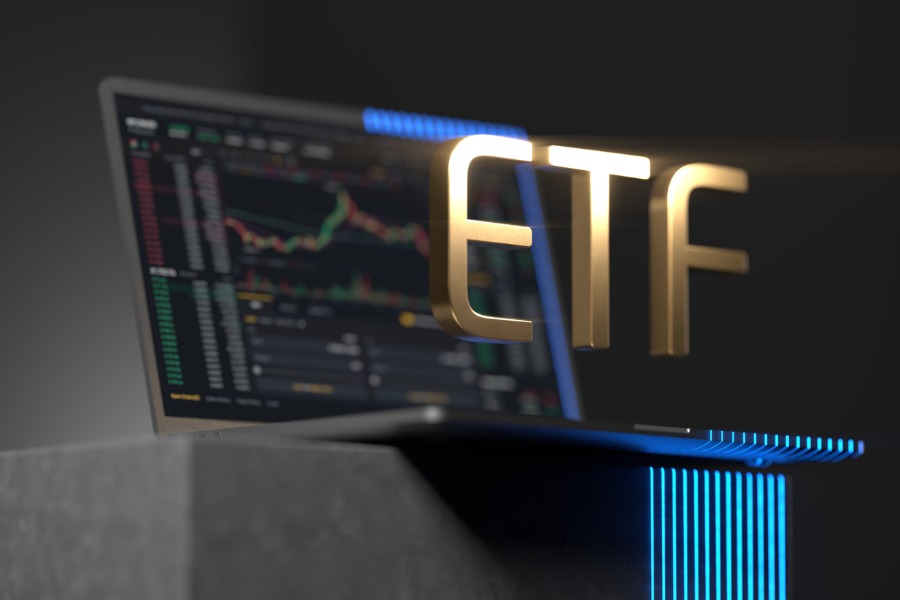

Half your coworkers might have just spent August in Europe, but there were no holiday doldrums in the booming world of ETFs.
Fueled by big cross-asset gyrations on Wall Street, investors added $75 billion to US exchange-traded funds last month, five times more than the same period in 2023. It may well prove the tipping point that keeps inflows roaring toward another historic annual cash haul, after July saw $122 billion — the second-biggest monthly intake ever.
The next few months promise plenty more volatility, between the expected kickoff of the Federal Reserve’s easing cycle, the US presidential election and year-end tax-loss harvesting and portfolio rebalancing. It’s a stretch that is poised to drive fresh allocations among institutional managers, at a time when retail investors are also riding all manner of ETFs to navigate the stock rally.
After reeling in $609 billion so far in 2024, ETFs as a whole have already exceeded the tally for each of the past two years. They’re on pace to approach — or even surpass — the record $911 billion addition in the low-rate-anything-goes era of 2021, data from Bloomberg Intelligence show.
It’s an extraordinary feat, underscoring bullish appetites across investing styles. And it speaks to the explosive growth in the now nearly-$10 trillion space, where 3,600 funds offer the ability to allocate money toward just about any asset class.
“It was an unusually eventful summer,” said Athanasios Psarofagis, an ETF analyst at Bloomberg Intelligence. “You had investors piling into bonds, buying the dip on stocks, rotating into small caps — it’s a recipe for strong flows.”
The upshot is that ETFs now account for almost a third of total fund assets, double the ratio from 2015, BI data through July show. And it’s not all about passive index-tracking investing. The universe of actively managed ETFs has grown by more than 30% this year, to $783 billion, while assets in the passive segment have risen about 15%, to $8.6 trillion.
Both fixed-income and equity products have seen strong demand, with the former seeing a 2024 intake of $187 billion and the latter $367 billion. The bond inflows have been a major boost this year given how many new offerings are now available, including actively managed ones, according to Todd Sohn, an ETF strategist at Strategas.
He highlighted two standouts: the BlackRock Flexible Income ETF (ticker BINC), which has taken in $3.5 billion, and the Capital Group Core Bond ETF (CGCB), which has attracted $950 million.
All in, bond ETFs have taken in $100 billion over the past three months, more than was seen during the early pandemic-recovery months in 2020, according to Strategas.
But other areas have also been surprise hits, including a batch of new Bitcoin-based ETFs, which have seen net inflows of more than $17 billion. Plus, a deluge of launches of more complex funds, including covered-call and downside-protection ones, have added to the overall flow, said Sohn. Meanwhile, leveraged and inverse funds based on single companies have reached more than $9 billion in assets.
When ETF flows hit their prior record, in 2021, different areas were the biggest contributors. At the time, thematic ETFs were a big hit — Cathie Wood’s ARK Innovation ETF (ARKK), a poster child for the type of fund that was popular during that era — took in $4.6 billion that year.
This year, tech funds are raking in cash, thanks to the surge in the biggest technology stocks, “so any investment allocations to other sectors will help towards the record,” said Sohn at Strategas. But it also shows “how other corners, like fixed income, crypto — have stepped up to boost the overall industry tally.”

Meanwhile, Fifth Third's RIA arm adds a former billion-dollar BNY trio in Boulder, Colorado, while a hybrid RIA opens a new North Carolina location with a former Raymond James-affiliated team.

Analysis highlights swelling out-of-pocket costs and wasted time on paperwork, with an outsized toll on businesses and around crypto transactions.

The appointment to its investment management arm comes roughly a year after the firm first announced plans to launch its own exchange-traded fund platform.

With trillions of dollars in transit, HNW expert sees a bigger picture.

Summit Financial unveiled a suite of eight new tools, including AI lead gen and digital marketing software, while MassMutual forges a new partnership with Orion.
Orion's Tom Wilson on delivering coordinated, high-touch service in a world where returns alone no longer set you apart.
Barely a decade old, registered index-linked annuities have quickly surged in popularity, thanks to their unique blend of protection and growth potential—an appealing option for investors looking to chart a steadier course through today's choppy market waters, says Myles Lambert, Brighthouse Financial.
